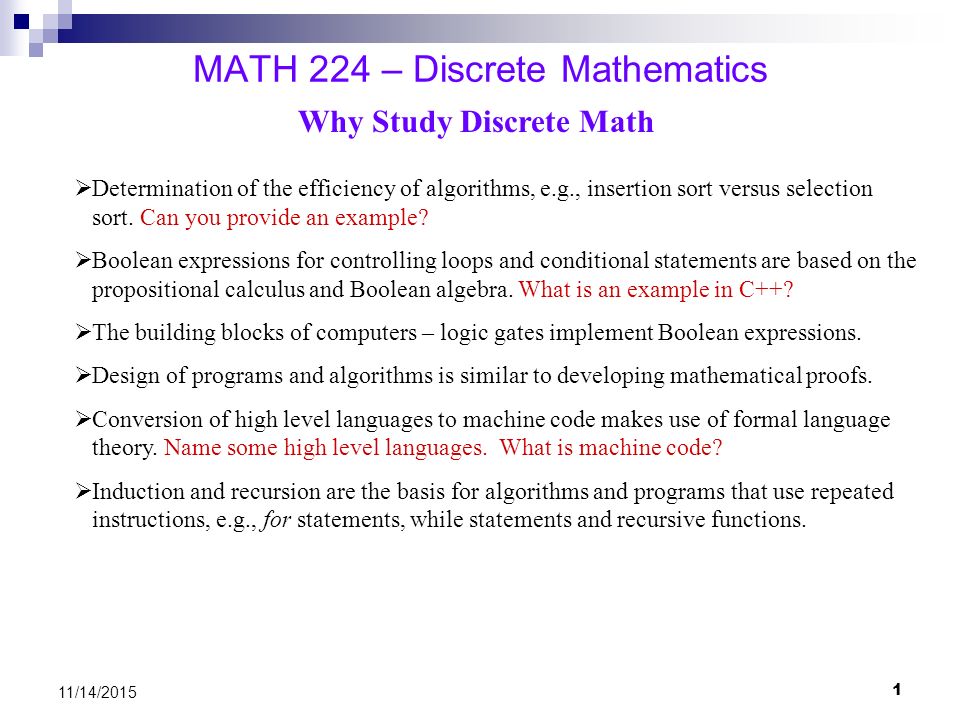
For a one- or two-term introductory course in discrete mathematics. Chapters 2 (The Language of Mathematics) and 3 (Relations) in the sixth edition have been combined into Chapter 3 (Functions, Sequences, and Relations) in this revision. 13 Computational Geometry. Enigma love sensuality devotion the greatest hits rar. 13.1 The Closest-Pair Problem. 13.2 An Algorithm to Compute the Convex. Discrete geometry and combinatorial geometry are branches of geometry that study combinatorial properties and constructive methods of discrete geometric objects. Most questions in discrete geometry involve finite or discrete sets of basic geometric objects, such as points, lines, planes, circles, spheres, polygons, and so forth.
• Regardless of the course level, courses will be consistent with the [PDF] for high school. [PDF] offers a starting point for developing courses that align with these standards. • Courses will also recognize the hierarchical nature of mathematics, and advanced courses (referenced in #3 below) should demonstrate growth in depth and complexity, both in mathematical maturity as well as in topical organization. • Courses may be part of the traditional Algebra 1 - Geometry - Algebra 2 sequence or other sequences that may treat these topics in an integrated fashion. In addition, acceptable courses may be combinations of integrated courses, algebra, geometry, and other courses that address the [PDF], including courses that apply these standards in the development of career-related skills. • Courses that use mathematical concepts, include a mathematics prerequisite, and are intended for 11th and/or 12th grade levels are also eligible for approval.
Psychology and work today 10th edition free pdf. Engineering Psychology Part VI: Consumer Psychology 14. Schultz is a former professor of psychology at the University of South Florida. About the Author(s) Duane P. Consumer Psychology.
• Such courses may incorporate math in an applied form in conjunction with science or career technical education. They must deepen students’ understanding of mathematics by incorporating the depth described in the ICAS Statement on Competencies in Mathematics Expected of Entering College Students [PDF]. • Examples of such courses include, but are not limited to, trigonometry, linear algebra, pre-calculus (analytic geometry and mathematical analysis), calculus, discrete math, probability and statistics, and computer science. For instance, a computer science course with primary focus on coding methods alone would not fulfill the mathematics requirement, whereas one with substantial mathematical content (e.g., mathematical induction, proof techniques, or other topics from discrete mathematics) could satisfy the requirement.
• Courses that are based largely on repetition of material from a prerequisite or prior course (e.g., as test preparation or pre-college review) will not be approved. • Most approved courses will satisfy a single year of the subject requirement, with a few exceptions: • A course covering only trigonometry, for example, would fulfill only half a year, but a single course covering trigonometry with significant integration of other advanced math content related to pre-calculus could fulfill one year of the requirement. • Mathematics courses taken over multiple terms that go beyond one year (e.g., three or four semesters) are acceptable but the course will be approved to satisfy only one year (or two semesters) of study. Courses that satisfy this subject requirement will support students to: • Apply mathematical knowledge in a way that allows them to analyze and understand a broad array of phenomena (i.e., math is more than just rote memorization of definitions, algorithms, and/or theorems). • Use mathematics to grasp and persevere in solving unfamiliar problems, and justify their solutions to those problems based on understanding the purpose behind each concept and skill they apply.
• Find and use patterns of reasoning or structure, make and test conjectures, try multiple representations (e.g., symbolic, geometric, graphical) and approaches (e.g., deduction, mathematical induction, linking to known results). • Make abstractions and generalizations and verify that solutions are correct, approximate, or reasonable.

• Use mathematical models to guide their understanding of the world around us. Honors-level mathematics (C) courses will be demonstrably more challenging than non-honors courses, and will fulfill the following criteria: •. • Have three years of college-preparatory mathematics as prerequisite work.
• Be at the mathematical analysis (pre-calculus) level or above. • Mathematical analysis that includes the mathematical development of the trigonometric, logarithmic, and exponential functions can be approved for UC honors credit. • Honors-level courses in mathematics can be designed as differentiation within heterogeneous classrooms, as long as the depth of instruction and assessment parallel the rigor of AP (Advanced Placement) and IB (International Baccalaureate) course expectations. • Calculus, with four years of college-preparatory mathematics as prerequisite, qualifies as an honors-level course if it is substantially equivalent to an AP Calculus course. • Statistics, with a three-year mathematics prerequisite, may be approved for honors credit if it is substantially equivalent to an AP Statistics course. Courses in the mathematics (C) subject area should be designed to give students the following competencies and should demonstrate how students will acquire them: • A view that mathematics is not just a collection of definitions, algorithms, and/or theorems to memorize and apply, but rather is a coherent and tightly organized body of knowledge that provides a way to think about and understand a broad array of phenomena. • A proclivity to put time and thought into using mathematics to grasp and solve unfamiliar problems.